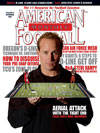AMERICAN FOOTBALL MONTHLY THE #1 RESOURCE FOR FOOTBALL COACHES
Article CategoriesAFM Magazine
|
The Situation© More from this issueYour team is playing its opening game against the top ranked team in the league. You’ve just come off a great summer camp that enabled you to put in three offensive packages (Spread, Pro and Wishbone) and this year you have the personnel to run them all. It’s been a tough game so far, having lost your starting QB in the second series of the game. The score is tied 28-28. The kick return team did a great job just getting the ball back to your opponent’s 40-yard line with 1:30 left on the clock. The defense is playing a stack 3-3 with a Tampa 2 coverage mixed with rolling to Cover 3/boundary side of the field. What’s your play call on this first and ten? Daryl Williamson, Head Coach, Panama HS (OK). AFM subscriber since 2007. First off, we would be in the spread package....The full article can only be seen by subscribers. Subscribe today!
|
|
|||||||
| HOME |
MAGAZINE |
SUBSCRIBE | ONLINE COLUMNISTS | COACHING VIDEOS |
Copyright 2025, AmericanFootballMonthly.com
All Rights Reserved





